The most beautiful climbing plants for the garden: annuals and perennials
Climbing plants have a special place in the design of garden plots. These plants can be used to decorate any vertical surface: a fence, gazebo, the house itself. They are able to hide surface imperfections and turn any area into a real blooming garden. Climbing plants tend to grow rapidly, especially annuals. They create a certain shade and hide the area from the prying eyes of neighbors.
Content:
- Features of the use of climbing plants for the garden
- Annual climbing plants
- Perennial decorative
- Correct care
Features of the use of climbing plants for the garden
There are many varieties and varieties of climbing plants. They differ in appearance, characteristics, features leaving... These plants can be conditionally divided into 3 groups:
- Creeping. These garden climbing plants are rarely intended for vertical design because they need to be tied up. They do not have devices for self-braiding of vertical surfaces, but they have long, heavy stems, which, with active growth, can spread out, creating the effect of a carpet.
- Clinging. These plants are attached to vertical surfaces with the help of various processes and tendrils, but it is also recommended to additionally support and tie them up.
- Climbing. This group of surfaces is able to adhere to vertical surfaces independently with the help of suction cups. However, the surface should be rough and not completely smooth.
If there is a desire to decorate the house directly, then it is better to choose vines, which will themselves cling to the brickwork. For fences and netting, ordinary bindweed are suitable, which will only need to be supported and guided occasionally.
There is an opinion that such plants destroy plaster, so you cannot decorate the house with them. However, these fears are unfounded. Vine suction cups are not capable of destroying plaster. On the contrary, they protect it from the harmful effects of the sun, reducing temperature fluctuations, protecting the wall from moisture and rain.
Vines and other climbing plants should not be planted next to a damaged wall of the house.
If there are already irregularities and damage, plants will penetrate them, increasing the cracks in the lining. Such plants, planted near houses, need especially careful care so that they do not have to suck water out of the plaster. With proper care, no dampness and mold will form on the wall under the foliage. On the contrary, climbing plants protect the wall from dampness and dry out the soil around a little. If the waterproofing is broken in the house, it is not recommended to plant plants with suction cups next to it. It is better to make supports at some distance from the house and plant ordinary bindweed with antennae. Do not plant climbing plants next to new cladding. She needs to be given at least a year to dry completely.
Annual climbing plants
Annual climbing plants have to be planted again every year, growing them in seedlings or planting them directly in open ground.The peculiarity of annuals is that they grow faster, bloom earlier and grow stronger. Bloom some annuals can last until the very frost.
The choice of annual climbing plants is quite wide. They differ not only in appearance, but also in the complexity of care.
It is advisable for novice gardeners to choose unpretentious plants:
- Morning glory... This is a fairly common climbing plant with bright bell-shaped flowers. She grows quickly, looks great and is not too whimsical to care for. For morning glory to grow well and bloom magnificently, it is enough to choose the right soil and water it regularly. However, it is worth remembering that the buds are opened in the morning, but closed by noon, and on a cloudy day they may not open at all. It is advisable to plant morning glory not in the most windy places. For good growth, the flower needs support, preferably a metal mesh.
- Sweet pea. One of the most common and beautiful climbing plants that gardeners often use to decorate their plots, gazebos, fences. Sweet pea varieties have a rich spectrum of colors, the plant is unpretentious in care, it blooms very beautifully and blooms for a long time and produces a unique aroma. Pea stems cling to the support with tendrils, so they often need to be tied up. The bright flowers resemble butterflies. The plant begins to bloom in mid-summer. If you gradually cut off the bean-like fruits, flowering will continue for a long time, until the first frost.
- Hyacinth beans. This plant is also called dolichos or curly lilac. Small lilac-purple pods, as well as the flowers themselves, give the plant the appearance of bunches of lilacs. The beans are edible. Dolichos is grown by seedling method. After planting in open ground, it is necessary to consider a support for the stretching stems.
- The nasturtium is large. A beautiful climbing annual plant with bright yellow buds with a pleasant aroma. The stems can reach a length of 2 m. This plant loves warmth, so it is planted later than the rest, when the weather is warm. This plant does not like transplantation and does not tolerate well. Therefore, when growing seedlings it is better to use special peat containers or cups with a retractable bottom so as not to injure the roots.
Perennial decorative
Perennial climbing ornamental plants, in contrast to annuals, have a more powerful developed root system... They survive the cold, fall into a dormant state, and then grow again. Their stems, as a rule, are thicker, stronger and require more solid support.
Perennials are suitable for gardeners who prefer consistency and do not like to change their ornamental plants every year.
Types of plants:
- Actinidia... This is a perennial vine, on which small green fruits appear, resembling grape... At the end of spring, it already begins to bloom. Actinidia flowers have a wonderful delicate aroma with a light citrus note. This plant is very hardy, it can withstand temperatures as low as -45 degrees, but it may not survive spring frosts after planting. Actinidia berries are edible and may taste slightly different depending on the variety.
- Ivy... Garden ivies grow very quickly, braiding the support with dense greenery, do not require special care and have high decorative qualities. Ivy leaves can be green, variegated, with a pattern, depending on the variety. Ivy is not bright and beautiful floweringbut its fruit definitely makes the plant even more decorative. It is better to plant ivy with variegated leaves in more sunny places so that the color does not fade.
- Maiden grapes... An incredibly beautiful and useful climbing plant, which is convenient for covering alleys, gazebos to create shade. Its foliage is very dense and beautiful, from dark green to burgundy red. In addition, girlish grapes practically do not need care, even a beginner can grow it.Shoots can be up to 20 m long if not shortened.
- Climbing rose... This climbing plant looks luxurious, but like any the Rose, rather capricious in leaving. The rose needs to be pruned regularly, feed, protect from insects and adverse environmental conditions and insulate for the winter. They are planted in well-lit areas without excess moisture. In wetlands, the rose grows poorly.
- Wisteria... Subtropical tree-like wisteria looks very exotic. She is able to decorate any site and turn it into a luxurious garden. Wisteria takes up a minimal amount of area, but when it blooms, it looks very beautiful, the bunches of its flowers resemble a waterfall.
Correct care
Climbing plants are resistant and relatively unpretentious. Some of them even need only landing and timely watering... Moreover, they can not only decorate the garden, but also bear fruit, bringing benefits in the form of delicious fruits full of vitamins.
When growing climbing plants, it is worth remembering that not all of them are able to independently climb a wall or fence. Many people need a garter and additional support. This should be looked at according to the situation. If the plant cannot rise to a sufficient level, its stems are too long and heavy, they need to be fixed. Most bindweed and vines look normal at first. seedlings... Only gaining the growth and length of the stem, they begin to actively curl and crawl up. There is no need to tie them up right away.
When planting a plant, it is worth considering the maximum length of its shoots.
For braiding a house or a gazebo, it is better to choose plants with longer stems. Vines bloom at different times. Some in May, others only in August. Plants that bloom early are considered to be the most generous in yield. In order for climbing plants to grow quickly and bloom luxuriantly, the soil must be prepared for landing (for annuals). In the spring, the soil is carefully dug up and fertilized with humus.
If you plan to ennoble the facade of the building with climbing plants, they do not need to be planted too close. The distance from the wall should be about 20 cm in order for the root system of the plant to grow freely. The distance between the seedlings should also be sufficient. If the shoots are too long and the foliage is dense, there should be a distance of about 2 m between the plants.
Such ornamental plants need to be constantly guided and trimmed, depending on the gardener's idea. They need to be shaped by removing excess length and thinning the plant. You cannot plant vines next to a drain. Water will drain from rooftops, causing plant diseases and waterlogging of the soil. It is also not recommended to plant them next to lightning protection equipment and wires. Some vines are very vigorous and have heavy stems that can damage the wires.
More information can be found in the video.



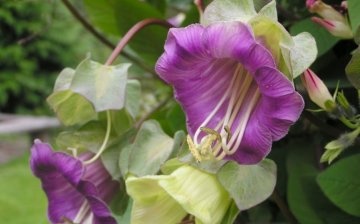
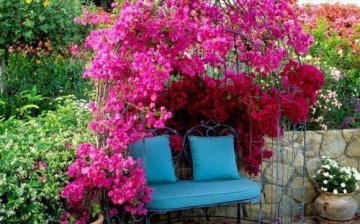
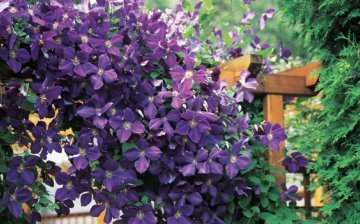
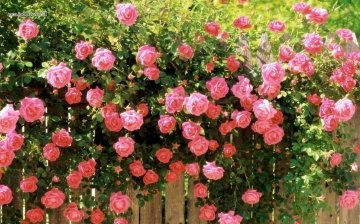
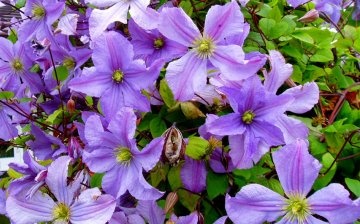





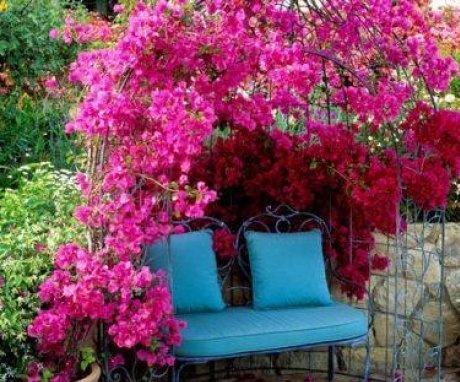
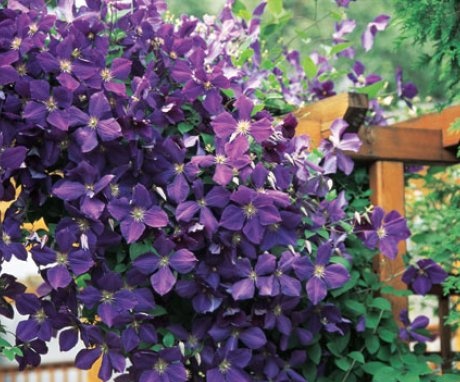
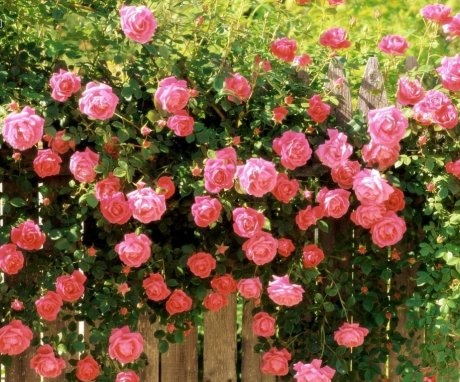
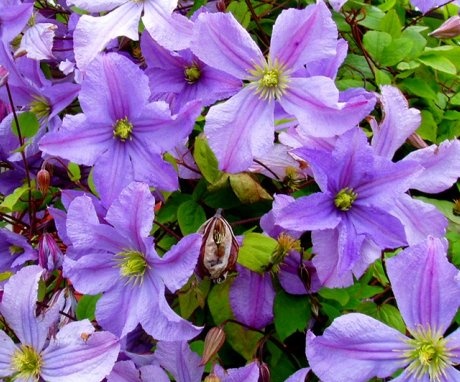
The rose is certainly gorgeous, what kind of plants do you have in the second photo, where the shop is braided with flowers? It looks very nice and in a designer way, I would also have got myself such a plant, I liked it.
From perennial flowers, I grow a rose and ivy. Of course, it is much more difficult to care for a rose than for ivy, but it's worth it. During flowering, there is a wonderful aroma and unique beauty. Ivy grows by itself, it only requires watering and pruning.